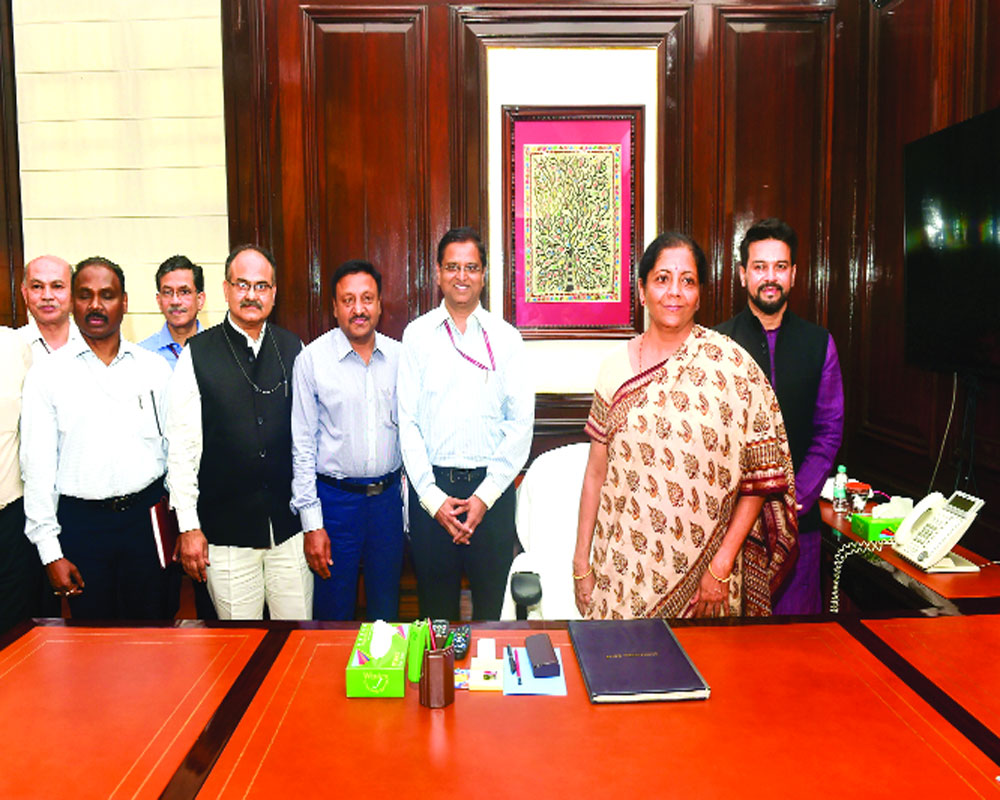Sitharaman becomes first woman in 48 yrs to head FinMin at a time GDP growth is at 5-yr low & unemployment on 45-yr high
The biggest surprise in the portfolio allocation of the Modi Cabinet on Friday was crucial Finance Ministry going to Nirmala Sitharaman, who was immediately greeted by the forecast of a sagging economy which saw GDP falling to a five-year low of 5.8 per cent and the Government admitting that the unemployment has hit a 45-year high figure.
Nirmala became the first woman in 48 years since then Prime Minister Indira Gandhi to hold charge of the Finance Minister. Nirmala, who became the first full-time woman Defence Minister in the first tenure of the BJP Government, will also head the Corporate Affairs Ministry.
Indira — who handled the Finance Ministry in 1970-71 — as PM had held additional charge of the Defence Ministry.
Among the BJP leaders, Niramala is a relatively junior face in the Modi Government.
She joined the BJP in 2008 and was made a member of the National Executive. She was nominated as party spokesperson in March 2010 and has been a full time party worker since then. Her elevation as Finance Minister has raised eyebrows both within and outside the BJP.
Nirmala took over as Defence Minister in September 2017 taking over from Arun Jaitley, who was holding the portfolio as additional charge.
At a time when the GDP is falling, unemployment is rising, export and FDI flow slowing down, and credit off take and NPA emerging major area of concerns, news agency PTI quoted analysts as saying that the narrative in markets will be about economic policies that will be adopted to revive and stimulate the slowing economy.
“The ambiguity of portfolio allocation is now removed, so this is good for the market in a sense. We will get to see new Finance Minister Nirmala’s proposals and approach in the Budget due in about a month,” said Jagannadham Thunuguntla, Sr VP and Head of Research, Centrum Broking Limited.
“Emergence of clarity is what was important, and now narrative in markets will be about the economic policies that will be adopted to revive and stimulate the slowing economy,” he said.
Meanwhile, India’s economic growth rate slowed to five-year low of 5.8 per cent in January-March 2018-19, due to poor performance in agriculture and manufacturing sectors, official data released on Friday said.
The Central Statistics Office (CSO) also revealed that GDP growth during 2018-19 fiscal stood at 6.8 per cent, lower than 7.2 per cent in the previous financial year. The growth in GDP was slowest since 2014-15. The previous low was 6.4 per cent in 2013-14. The fourth quarter growth was below China’s 6.4 per cent.
On the unemployment front, Nirmala faced the daunting task of dealing with jobless growth. Months after rejecting the claim that India’s unemployment rate had touched a 45-year high, the Narendra Modi Government admitted the same on Friday with the latest data showing that joblessness had indeed touched 6.1 per cent from July 2017 to June 2018. The unemployment rate is defined as the percentage of persons unemployed among the total labour force.
The data released by the Government on a day when Modi 2.0 Cabinet took charge showed 7.8 per cent of all employable urban youth being jobless, while the percentage for the rural was 5.3 per cent. The joblessness among males on all India basis was 6.2 per cent, while it was 5.7 per cent in case of females.
The data comes from the Periodic Labour Force Survey (PLFS), which was conducted by the National Sample Survey Office (NSSO) from July 2017 to June 2018, and covered 4.3 lakh people across 1.02 lakh households. The PLFS notes that the all-India unemployment rate was at 6.1 per cent for 2017-18, the highest since 1972-73.
As per data, share of self-employed among workers was about 57.8 per cent among rural males, 57.7 per cent among rural females, 39.2 per cent among urban males and 34.7 per cent among urban females. Among regular wage/salaried employees in the non-agriculture sector, 71.1 per cent had no written job contract: 72.3 per cent among males and 66.8 per cent among females.
The data showed joblessness for rural male youth (aged 15-29) went from 5 per cent in 2011-12 to 17.4 per cent in 2017-18. For rural women in the same age group, joblessness went from 4.8 per cent in 2011-12 to 13.6 per cent in 2017-18.
The Government had earlier brushed aside a leaked official report on the country’s poor job scenario and maintained that the unemployment data was yet to be finalised. The Modi Government had come under fire for withholding the key macro data, with the Opposition parties alleging that it was a deliberate attempt to hide its non-performance. Moreover, some members of the Statistical Commission had earlier resigned to protest against the Government’s decision to withhold the data.
The data poses a huge challenge to the Modi Government which has returned to power for the second term on the promise that it will set policies right and ensure faster economic growth and employment. The data is also significant because this was the first comprehensive assessment of the employment situation conducted after Modi’s decision in November 2016 to withdraw most of the country’s banknotes from circulation overnight.


























